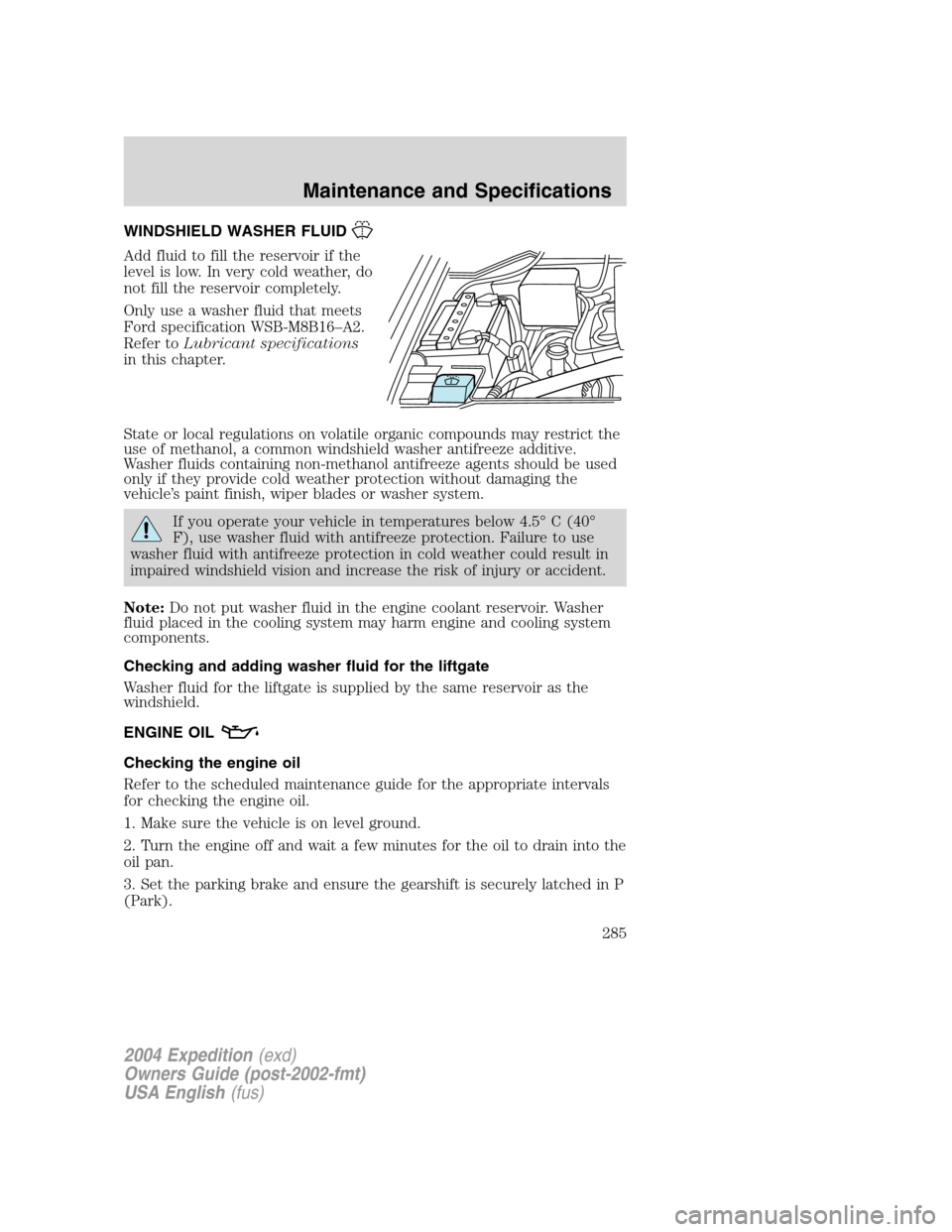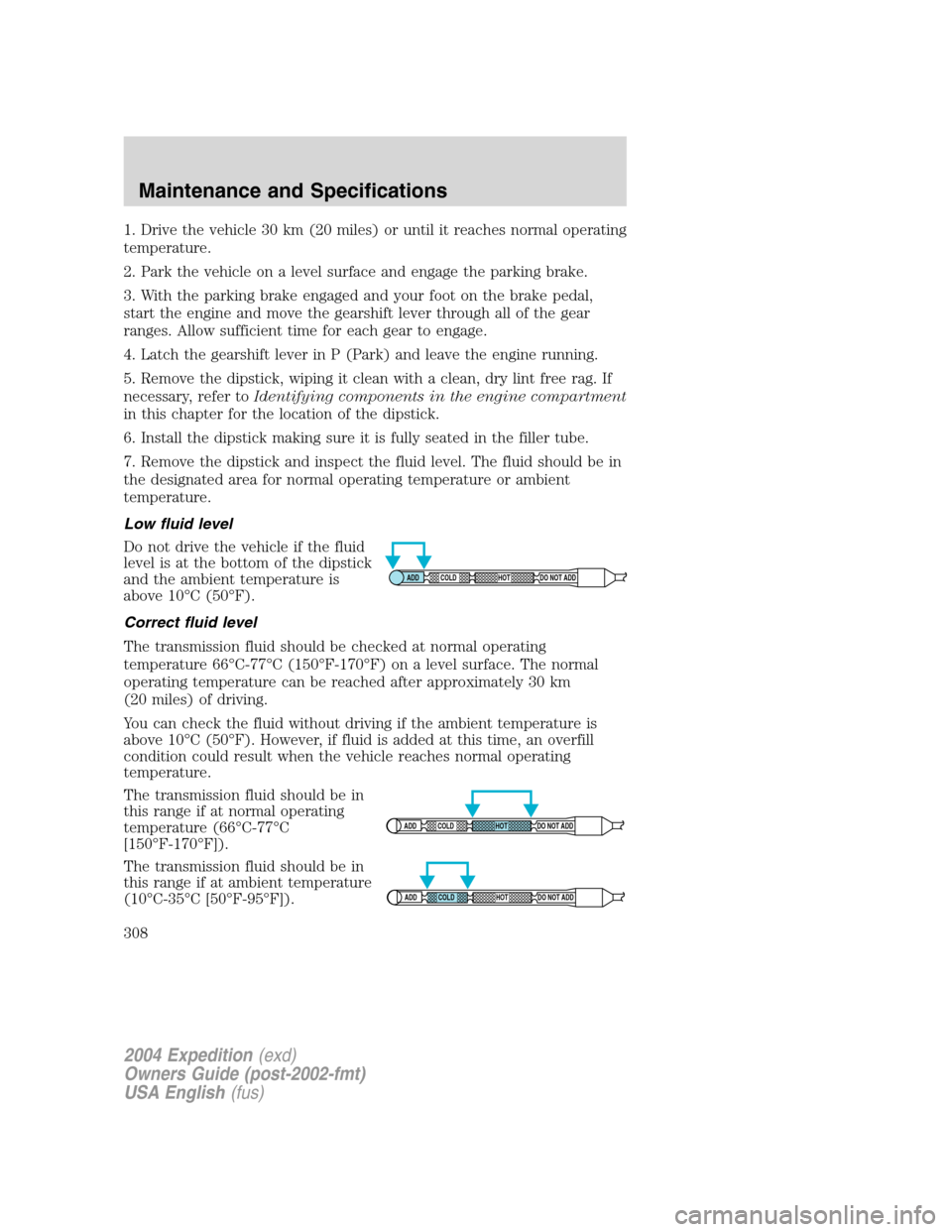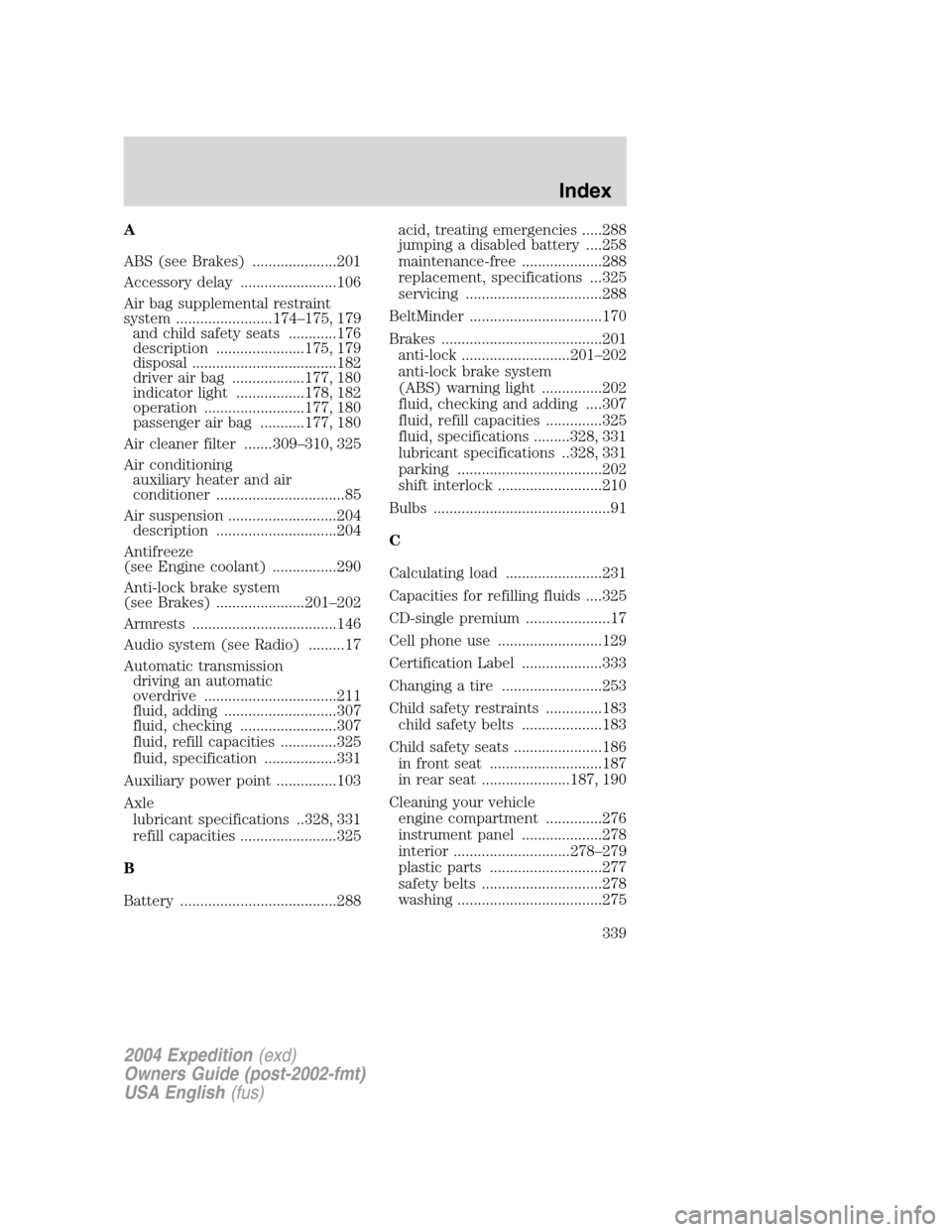2004 FORD EXPEDITION parking brake
[x] Cancel search: parking brakePage 281 of 344

SERVICE RECOMMENDATIONS
To help you service your vehicle:
•We highlight do-it-yourself items in the engine compartment for easy
location.
•We provide a scheduled maintenance guide which makes tracking
routine service easy.
If your vehicle requires professional service, your dealership can provide
the necessary parts and service. Check yourWarranty Guide/Owner
Information Guideto find out which parts and services are covered.
Use only recommended fuels, lubricants, fluids and service parts
conforming to specifications. Motorcraft parts are designed and built to
provide the best performance in your vehicle.
PRECAUTIONS WHEN SERVICING YOUR VEHICLE
•Do not work on a hot engine.
•Make sure that nothing gets caught in moving parts.
•Do not work on a vehicle with the engine running in an enclosed
space, unless you are sure you have enough ventilation.
•Keep all open flames and other lit material away from the battery and
all fuel related parts.
Working with the engine off
1. Set the parking brake and shift to P (Park).
2. Turn off the engine and remove the key.
3. Block the wheels.
Working with the engine on
1. Set the parking brake and shift to P (Park).
2. Block the wheels.
Note:Do not start your engine with the air cleaner removed and do not
remove it while the engine is running.
2004 Expedition(exd)
Owners Guide (post-2002-fmt)
USA English(fus)
Maintenance and Specifications
Maintenance and Specifications
281
Page 285 of 344

WINDSHIELD WASHER FLUID
Add fluid to fill the reservoir if the
level is low. In very cold weather, do
not fill the reservoir completely.
Only use a washer fluid that meets
Ford specification WSB-M8B16–A2.
Refer toLubricant specifications
in this chapter.
State or local regulations on volatile organic compounds may restrict the
use of methanol, a common windshield washer antifreeze additive.
Washer fluids containing non-methanol antifreeze agents should be used
only if they provide cold weather protection without damaging the
vehicle’s paint finish, wiper blades or washer system.
If you operate your vehicle in temperatures below 4.5°C (40°
F), use washer fluid with antifreeze protection. Failure to use
washer fluid with antifreeze protection in cold weather could result in
impaired windshield vision and increase the risk of injury or accident.
Note:Do not put washer fluid in the engine coolant reservoir. Washer
fluid placed in the cooling system may harm engine and cooling system
components.
Checking and adding washer fluid for the liftgate
Washer fluid for the liftgate is supplied by the same reservoir as the
windshield.
ENGINE OIL
Checking the engine oil
Refer to the scheduled maintenance guide for the appropriate intervals
for checking the engine oil.
1. Make sure the vehicle is on level ground.
2. Turn the engine off and wait a few minutes for the oil to drain into the
oil pan.
3. Set the parking brake and ensure the gearshift is securely latched in P
(Park).
2004 Expedition(exd)
Owners Guide (post-2002-fmt)
USA English(fus)
Maintenance and Specifications
285
Page 290 of 344

battery. When the battery is disconnected or a new battery is installed,
the engine must relearn its idle and fuel trim strategy for optimum
driveability and performance. To begin this process:
1. With the vehicle at a complete stop, set the parking brake.
2. Put the gearshift in P (Park), turn off all accessories and start the
engine.
3. Run the engine until it reaches normal operating temperature.
4. Allow the engine to idle for at least one minute.
5. Turn the A/C on and allow the engine to idle for at least one minute.
6. With your foot on the brake pedal and with the A/C on, put the
vehicle in D (Drive) and allow the engine to idle for at least one minute.
7. Drive the vehicle to complete the relearning process.
•The vehicle may need to be driven 16 km (10 miles) or more to
relearn the idle and fuel trim strategy.
•If you do not allow the engine to relearn its idle trim, the idle
quality of your vehicle may be adversely affected until the idle
trim is eventually relearned.
If the battery has been disconnected or a new battery has been installed,
the clock and the preset radio stations must be reset once the battery is
reconnected.
•Always dispose of automotive
batteries in a responsible manner.
Follow your local authorized
standards for disposal. Call your
local authorized recycling center
to find out more about recycling
automotive batteries.
ENGINE COOLANT
Checking engine coolant
The concentration and level of engine coolant should be checked at the
mileage intervals listed in the scheduled maintenance guide. The coolant
concentration should be maintained at 50/50 coolant and distilled water,
which equates to a freeze point of -36°C (-34°F). Coolant concentration
LEAD
RETURN
RECYCLE
2004 Expedition(exd)
Owners Guide (post-2002-fmt)
USA English(fus)
Maintenance and Specifications
290
Page 308 of 344

1. Drive the vehicle 30 km (20 miles) or until it reaches normal operating
temperature.
2. Park the vehicle on a level surface and engage the parking brake.
3. With the parking brake engaged and your foot on the brake pedal,
start the engine and move the gearshift lever through all of the gear
ranges. Allow sufficient time for each gear to engage.
4. Latch the gearshift lever in P (Park) and leave the engine running.
5. Remove the dipstick, wiping it clean with a clean, dry lint free rag. If
necessary, refer toIdentifying components in the engine compartment
in this chapter for the location of the dipstick.
6. Install the dipstick making sure it is fully seated in the filler tube.
7. Remove the dipstick and inspect the fluid level. The fluid should be in
the designated area for normal operating temperature or ambient
temperature.
Low fluid level
Do not drive the vehicle if the fluid
level is at the bottom of the dipstick
and the ambient temperature is
above 10°C (50°F).
Correct fluid level
The transmission fluid should be checked at normal operating
temperature 66°C-77°C (150°F-170°F) on a level surface. The normal
operating temperature can be reached after approximately 30 km
(20 miles) of driving.
You can check the fluid without driving if the ambient temperature is
above 10°C (50°F). However, if fluid is added at this time, an overfill
condition could result when the vehicle reaches normal operating
temperature.
The transmission fluid should be in
this range if at normal operating
temperature (66°C-77°C
[150°F-170°F]).
The transmission fluid should be in
this range if at ambient temperature
(10°C-35°C [50°F-95°F]).
ADD COLD HOT DO NOT ADD
ADD COLD HOT DO NOT ADD
ADD COLD HOT DO NOT ADD
2004 Expedition(exd)
Owners Guide (post-2002-fmt)
USA English(fus)
Maintenance and Specifications
308
Page 339 of 344

A
ABS (see Brakes) .....................201
Accessory delay ........................106
Air bag supplemental restraint
system ........................174–175, 179
and child safety seats ............176
description ......................175, 179
disposal ....................................182
driver air bag ..................177, 180
indicator light .................178, 182
operation .........................177, 180
passenger air bag ...........177, 180
Air cleaner filter .......309–310, 325
Air conditioning
auxiliary heater and air
conditioner ................................85
Air suspension ...........................204
description ..............................204
Antifreeze
(see Engine coolant) ................290
Anti-lock brake system
(see Brakes) ......................201–202
Armrests ....................................146
Audio system (see Radio) .........17
Automatic transmission
driving an automatic
overdrive .................................211
fluid, adding ............................307
fluid, checking ........................307
fluid, refill capacities ..............325
fluid, specification ..................331
Auxiliary power point ...............103
Axle
lubricant specifications ..328, 331
refill capacities ........................325
B
Battery .......................................288acid, treating emergencies .....288
jumping a disabled battery ....258
maintenance-free ....................288
replacement, specifications ...325
servicing ..................................288
BeltMinder .................................170
Brakes ........................................201
anti-lock ...........................201–202
anti-lock brake system
(ABS) warning light ...............202
fluid, checking and adding ....307
fluid, refill capacities ..............325
fluid, specifications .........328, 331
lubricant specifications ..328, 331
parking ....................................202
shift interlock ..........................210
Bulbs ............................................91
C
Calculating load ........................231
Capacities for refilling fluids ....325
CD-single premium .....................17
Cell phone use ..........................129
Certification Label ....................333
Changing a tire .........................253
Child safety restraints ..............183
child safety belts ....................183
Child safety seats ......................186
in front seat ............................187
in rear seat ......................187, 190
Cleaning your vehicle
engine compartment ..............276
instrument panel ....................278
interior .............................278–279
plastic parts ............................277
safety belts ..............................278
washing ....................................275
2004 Expedition(exd)
Owners Guide (post-2002-fmt)
USA English(fus)
Index
Index
339
Page 343 of 344

Oil (see Engine oil) ..................285
P
Panic alarm feature,
remote entry system ................134
Parking brake ............................202
Parts (see Motorcraft parts) ....325
Pedals (see Power
adjustable foot pedals) .............108
Power adjustable foot pedals ...108
Power distribution box
(see Fuses) ...............................243
Power door locks ......................132
Power point ...............................103
Power steering ..................203–204
fluid, checking and adding ....306
fluid, refill capacity ................325
fluid, specifications .........328, 331
Power Windows .........................105
Preparing to drive
your vehicle ...............................207
R
Radio ............................................17
Rear window defroster ...............86
Relays ........................................242
Remote entry system .......133–134
illuminated entry ....................137
locking/unlocking
doors ........................132–134, 138
opening the trunk ...................134
panic alarm .............................134
replacement/additional
transmitters .............................137
Reverse sensing system ...........214Roadside assistance ..................239
Roof rack ...................................131
S
Safety Belt Maintenance ..........174
Safety belts (see Safety
restraints) ..........160, 163–166, 168
Safety Canopy ...........................179
Safety defects, reporting ..........274
Safety restraints ........160, 163–168
belt minder .............................170
extension assembly ................173
for adults .........................164–166
for children .....................182–183
lap belt ....................................168
safety belt maintenance .........174
warning light and chime..169–170
Safety seats for children ..........186
Seat belts
(see Safety restraints) .............160
Seats ..........................................145
child safety seats ....................186
climate control ........................149
memory seat ...................135, 148
SecuriLock passive
anti-theft system ...............141–143
Servicing your vehicle ..............281
Snowplowing .................................7
Spare tire (see
Changing the Tire) ...................253
Spark plugs,
specifications .....................325, 331
Special notice
utility-type vehicles ....................7
Specification chart,
lubricants ...........................328, 331
2004 Expedition(exd)
Owners Guide (post-2002-fmt)
USA English(fus)
Index
343